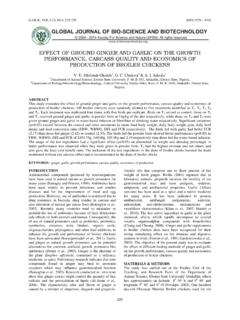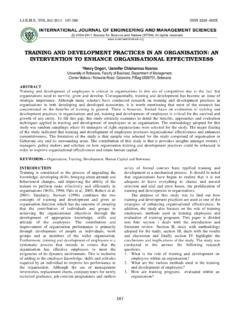Transcription of SEROPREVALENCE STUDY OF BOVINE BRUCELLOSIS IN …
1 , (3)2011:692-697 ISSN2229 6441692 Short CommunicationSEROPREVALENCE STUDY OF BOVINE BRUCELLOSIS INASSELAGOVERNMENT DAIRY FARMOF OROMIA REGIONAL STATE,ETHIOPIAD eselegn,Teklu Berhe& Gangwar, ofAnimal Secience and Ecotourism, Cpllege of Agriculture,Aksum University, Shire Campus, cross sectional STUDY was conducted to determine the sera-prevalence of BOVINE BRUCELLOSIS and to assess the risk factorsthat contribute for its occurrence in assela government dairy farm. The STUDY animals were comprised indigenous (Aris,Borena) and cross bred. All eligible animals in the farm, which were above 6 months of age were sampled and the serumcollected were first screened by Rose BengalePlate(RBP) test and all reactor sera were further tested byComplementFixationTest (CFT).
2 Information concerning age, sex, parity, breed and origin of the animals were gathered from recordbook in the farm. Moreover, information on abortion, retained placenta, still birth and theoverallhusbandry system of thefarm were gathered. Out of the 304 serum samples collected to 43 animals become positive with RBP test and the reactorswere further subjected to CFT for confirmation and all were found to be positive with an overall prevalence of (N=43). The result of chisquare analysis showed that there was significant variation in the prevalence of the diseasebetween the two ages (or= , and P< ). The result also indicated that there was significant difference in the serapositivity of BRUCELLOSIS between the twosexes with ) prevalence of the disease in female (41) in maleanimals (n=2) ( , and P< ).
3 The present STUDY also revealed sera prevalence of in the local cattle and incross bred once that were kept in the dry farm. Chi square analysis should that the difference in prevalence between thetwo breeds was highly statically significant and P value of Parity was also identified as one risk factor inthe farm in which significantly higher prevalence of brucellosiswas observed in cows that gave birth more than once( ) than first calfheifers (0%) (or= and P value = ).Furthermorethere was statically significant associationbetween serapositivityto BRUCELLOSIS and history of previous abortion (p< ) and retained fetal membrane and sill birth(p< ). In conclusion, all the risk factors assessed in the farm were found to be significant in the distribution andoccurrence of the diseases.
4 Control measures are also :- BOVINE , BRUCELLOSIS , Cattle, RBPT, CFT, assela , Intensive one of the developing countries, Ethiopia depends onnatural resources for its economic and social these resources, livestock is the primaryagricultural economic sectorto which the farmers live isdirectly or indirectly interrelated (Fukadu, 1999). Thecountry, Ethiopia has an enormous livestock resourceswith the total contribution of 15% of gross domesticproduct and 33% of the agriculturaloutput. Currentestimates show that there are million heads of cattle, million sheep and goats, million equine species, 1million camels and over 42 million poultry.
5 Thepopulation of dogs and cats not known; however, eachhouses hold in the rural area owns one or twodogs andowns a cat. There are also an estimated million househoney bee colonies contributing to the livelihood the ruralpopulation. The contribution of finishing at least 12 inland lakes and dams and many other rivers is also advancesin contribution of small ponds andhydroelectric dams are giving another opportunity for fishfarming (DADA, 2006). However, there is no substationprogress in livestock production due to various most common constraints are poor animal husbandrypractice, low genetic potential of the indigenous breed,and above all the prevalence of different diseases in theentire country.
6 The presences of these diseases make thelivestock industry less efficient, especially diseases havingnegative impact onlivestock export trade (Fukadu, 1999).In developed countries, animal trade is ruled by strongveterinary regulation and do not allow importing anyanimal species from the country having transmissiblediseases or from unknown diseases status countries. Inmost Africa and Asian countries, the regulation isrelatively low or totally absent as a result, the incursion ofexotic diseases is high in these countries. Therefore, to usethe huge livestock resource by reducing the impact ofmajor anima diseases having economic and zoon ticimportance such as BRUCELLOSIS , tuberculosis, PPR and etc,surveillance is essential.
7 In this STUDY , BRUCELLOSIS is takenas important problems to be investigated (Fukadu, 1999). BOVINE BRUCELLOSIS is a major zoonotic disease widelydistributed in both humans and animals especially in thedeveloping world (WHO, 1997). BOVINE BRUCELLOSIS is adisease of cattle usually caused by Brucella abortus lessfrequently by Brucella melitensis and rarely by Brucellasuis (Radostits el., 1994).It was first isolated and , (3)2011:692-697 ISSN2229 6441692 Short CommunicationSEROPREVALENCE STUDY OF BOVINE BRUCELLOSIS INASSELAGOVERNMENT DAIRY FARMOF OROMIA REGIONAL STATE,ETHIOPIAD eselegn,Teklu Berhe& Gangwar, ofAnimal Secience and Ecotourism, Cpllege of Agriculture,Aksum University, Shire Campus, cross sectional STUDY was conducted to determine the sera-prevalence of BOVINE BRUCELLOSIS and to assess the risk factorsthat contribute for its occurrence in assela government dairy farm.
8 The STUDY animals were comprised indigenous (Aris,Borena) and cross bred. All eligible animals in the farm, which were above 6 months of age were sampled and the serumcollected were first screened by Rose BengalePlate(RBP) test and all reactor sera were further tested byComplementFixationTest (CFT). Information concerning age, sex, parity, breed and origin of the animals were gathered from recordbook in the farm. Moreover, information on abortion, retained placenta, still birth and theoverallhusbandry system of thefarm were gathered. Out of the 304 serum samples collected to 43 animals become positive with RBP test and the reactorswere further subjected to CFT for confirmation and all were found to be positive with an overall prevalence of (N=43).
9 The result of chisquare analysis showed that there was significant variation in the prevalence of the diseasebetween the two ages (or= , and P< ). The result also indicated that there was significant difference in the serapositivity of BRUCELLOSIS between the twosexes with ) prevalence of the disease in female (41) in maleanimals (n=2) ( , and P< ). The present STUDY also revealed sera prevalence of in the local cattle and incross bred once that were kept in the dry farm. Chi square analysis should that the difference in prevalence between thetwo breeds was highly statically significant and P value of Parity was also identified as one risk factor inthe farm in which significantly higher prevalence of brucellosiswas observed in cows that gave birth more than once( ) than first calfheifers (0%) (or= and P value = ).
10 Furthermorethere was statically significant associationbetween serapositivityto BRUCELLOSIS and history of previous abortion (p< ) and retained fetal membrane and sill birth(p< ). In conclusion, all the risk factors assessed in the farm were found to be significant in the distribution andoccurrence of the diseases. Control measures are also :- BOVINE , BRUCELLOSIS , Cattle, RBPT, CFT, assela , Intensive one of the developing countries, Ethiopia depends onnatural resources for its economic and social these resources, livestock is the primaryagricultural economic sectorto which the farmers live isdirectly or indirectly interrelated (Fukadu, 1999).









